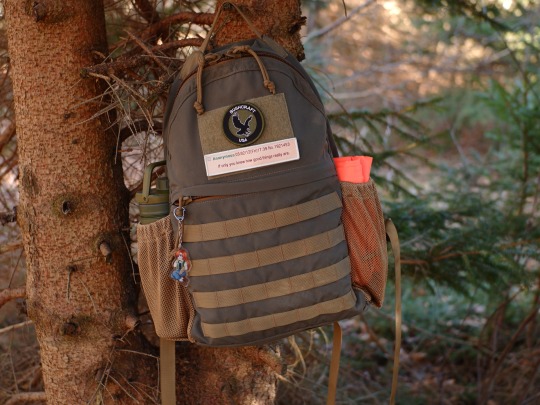#hiking gear
Text
Sharing library propaganda
2K notes
·
View notes
Text
Beginner Hiking Guide:
Gear - What to Bring Hiking

What you want to bring with you on a hike will vary depending on what kind of hike you’re doing. If you’re going on a very short (under an hour) and easy hike on highly-trafficked and easily accessed trails for instance, you may not need to bring much at all -- though I always recommend a water bottle, sun protection and a hoodie or something. But if you’re doing a longer trek on backcountry trails out in the wilderness, you’ll want to bring quite a bit more with you, because the stakes are higher if things go wrong.
My general rule of thumb is: Pack for the Worst Case Scenario.
What is the worst that could happen if you get lost or injured? How long would it take for someone to find you if your phone died and you couldn’t call for help? If you get stuck out overnight, how cold is it going to get, and will you be able to survive it? How about if you have to wait several hours for a rescue party to carry you out if you can’t walk?
I carry a bunch of emergency items in my pack that, on an ideal hike, I never need. But if things don’t go ideally, given the places and conditions I hike in, they could save my life. In the list below, I’ve put an asterisk next to items I recommend packing even for short day hikes (2 hours or less)
So let’s start with the most important thing:
You Need a Backpack.
If you’re going to carry supplies, you need something to carry them in, and a backpack is the easiest, most comfortable way to do so that won’t compromise your balance or leave you unable to use your hands on a hike. (On short outings, fannypacks are great, but you’ll want a backpack if you’re going out into backcountry).
DON'T: use a drawstring backpack -- this will dig painfully into your shoulders pretty quickly.
DO: use a backpack with a waist/hip strap (and chest strap if possible). Having more of your pack’s weight on your hips than on your shoulders will cut down on back pain! The more adjustable, the better; you want to be comfortable.
There are really great hiking specific backpacks out there, but they are on the pricey side. It’s something where, if you plan on doing hiking more regularly, I would recommend investing in a good pack, but for your first time your old book bag will probably do okay.
The Ten Essentials
If you do any research on backcountry hiking, you will probably see “the ten essentials” mentioned somewhere. These are the things that you’re recommended to always bring on a hike with you if you’re going out into the wilderness. The list can seem a little daunting, but honestly a lot of the things on it are pretty small and easy to acquire.
1) Navigation / Map & Compass* -- Have a paper map in a ziploc bag and a compass in addition to any digital tools and GPS you may be using to navigate. Technology fails, and having a map that you’ve familiarized yourself with before you set out will help you to stay on your route and avoid getting lost. REI has useful articles on how to use a compass and how to read a topographic map.
2) Nutrition / Extra Food -- I always bring food hiking. You burn through a lot of energy while hiking, and snacking will help boost your energy levels and keep you moving. Calorie-dense foods with sugar and protein like trail mix, nuts, and granola bars give you the biggest boost while not taking up too much room in your pack. And if your hike runs over, you’ll be grateful for the extra rations.
3) Hydration / Extra Water* -- I typically bring a full liter of water (or gatorade!), minimum when I hike. Nalgene bottles are great because they’re lightweight and virtually indestructible. You’re going to be losing a lot of moisture through sweat and through the vapor your exhale while breathing heavily, so you are going to need to hydrate. Bring more than you think you’re going to need in case things go badly.
4) Insulation / Extra Layers* -- I talked about this in the post about clothes, but always have an extra layer. If the weather shifts, or you get injured and can’t move to keep warm, or you get lost and need to wait for a rescue, the last thing you need is for hypothermia to come along and make your day worse.
5) Illumination / Light -- There’s always a chance of something going wrong, be it a twisted ankle or just misjudging the length of a hike, that can lead to you being out for longer than you anticipated -- and if you’re stuck out in the wilderness when the sun goes down, you want to be able to see where the hell you’re going to find the trail and get home. On any longer hike (especially if you’re starting later in the day), bring a headlamp or flashlight with extra batteries (and test it before you leave!)
6) Emergency Shelter -- Is there any chance that on the hike you’re doing, you could potentially get lost enough that you have to spend hours and hours out here? In the theme of extra layers, if you get lost, injured, or otherwise caught out in bad conditions and can’t hike out on your own for any reason and rescue won’t be there anytime soon (search and rescue teams take time to assemble, deploy and then hike out to you), you want to have some means of shelter. Obviously, you don’t wanna drag an entire tent out into the woods if you’re just going on a day hike, but a there’s a few lightweight options that can make a difference when you’re improvising protection from the elements, such as:
A mylar space blanket / shock blanket
A bivvy sack (basically a lightweight plastic sleeping bag that keeps warmth in and water out!)
....And if you’re on a budget, a large plastic trash bag can do in a pinch!
7) Firestarter -- On the topic of shelter, especially if you’re stuck out in the cold overnight, a fire can be an emergency source of heat and light. Since most of us are not capable of starting a fire just by rubbing two sticks together like in the movies, we’ll want to make it easier on ourselves by bringing something to start a fire with: pack something to ignite it with, and something to use as tinder to catch the flame and sustain it long enough to ignite other fuel you’ve gathered. I personally carry a bic lighter that was like, .99c at the gas station, and a toilet paper tube stuffed with dryer lint for tinder. This is one of those “hopefully you never actually have to use it” things.
8) First Aid Kit* -- You want to be able to treat an injury if it happens, and to address smaller health concerns before they become bigger health concerns. With blisters especially, an ounce of prevention is worth a pound of cure -- putting blister pads on your feet when you’ve got hot spots before they turn into full on oozing blisters is going to make a world of difference. And as someone who has taken a nasty spill on the trail and hiked out injured, I always carry a solid first aid kit with me. You can buy a compact pre-made kit easily enough to carry with you, but you may find yourself customizing it to your needs. I recommend having the following:
Ibuprofen -- good for managing pain, swelling, and soreness
Tylenol/Acetaminophen -- pain reliever, fever reducer, better for head injuries than ibuprofen since it doesn’t thin blood (also, if you’ve hurt yourself and you’re in a LOT of pain, you can alternate Tylenol and Ibuprofen)
Benadryl or some other antihistamine for allergies
AfterBite -- good for stings and bug bites
Bandaids in assorted sizes
Blister pads
Disinfectant wipes x 2
Gauze
A triangular bandage
A lightweight SAM splint
Ace bandage - good for wrapping sprains
Tweezers - good for removing splinters!
Any important medications you personally need, such as an EpiPen or inhaler, or personal joint braces you require
9) Sun Protection* -- Even if you’re hiking under tree cover, or on a cloudy day, with hours spent outdoors, you’re getting a lot of UV exposure. Regardless of whether you’re someone who sunburns easily or not, it’s good to have sun protection. Bring sunglasses and sunscreen, and consider wearing a hat. Especially at higher elevations, where the air gets thinner and blocks less UV radiation! And don’t forget when hiking in winter, that you can get snowblindness and sunburn from light reflected off snow.
10) Repair Kit + Knife / All That McGuyver Shit -- A few lightweight and simple objects can make it much easier to jury-rig a shelter, replace a snapped bootlace, or hold together a torn pack until you can get back to the parking lot. I personally always have:
A pocket knife/multitool
Flat-wrapped duct tape
Several safety pins
A handful of zip ties
A spare shoelace
And other people may find other items useful depending on their gear and the kind of repairs they might need.
In addition to the stuff on this list, there may be weather-specific or trail-condition specific gear you might need, like microspikes for traction on ice, or rain gear for hiking in wet climates. You can use your best judgment and the recommendations of others who have hiked where you are hiking to figure out what the best packing list is for your specific hike. This list is a guideline and a starting point.
Other things you may want to bring:
Whistle -- if your phone is dead and you’re waiting for rescue, you can blow on a whistle a lot longer (and a lot louder) than you can yell. Three short bursts usually means ‘hiker in distress’ and will help other hikers or searchers find you.
Toilet Paper + plastic bag -- If you don’t think you’re going to be able to hold it, bring a means to go in the woods. But bring the plastic bag to carry out your used toilet paper so it doesn’t pollute nature (Leave No Trace!)
A ziploc bag big enough for your phone -- if you need to cross a river or if it starts pouring, have a means to bag your phone to keep it dry. If there’s a risk of rain, bring a trash bag as well that you can use as an improvised pack cover to keep your stuff dry.
Insect Repellant -- even if you don’t bring it with you and just put it on in the parking lot, if you’re hiking in spring or summer especially, you’ll want some bug spray.
Keeping It Light
You want to pack smart, which means maximizing the usefulness of what you pack while keeping things as light as possible. Try using a lightweight plastic water bottle instead of a heavy steel one, and packing spare layers that are warm without being too bulky. Put sunblock in a small tube or bottle instead of packing the huge family-size one. The weight adds up, and the final weight of your pack is what you’re going to have to be carrying along with you. Though the good news is, your pack will get lighter as you consume the food and water you’ve packed!
If you are hiking with friends in a group, there’s some things you don’t really need multiple redundancies for -- if one person has a well-stocked first aid kit and another person carries enough sunblock for the group, you don’t need three of each and every item. Communicate with your group to make sure all your bases are covered, but also be sure you stay close together while hiking. Your friend having the group’s utility knife isn’t going to help you if you go off on your own and get separated. And you will all still want your own food, water, clothing, and light.
Organize Your Bag
Having the right gear is helpful. Knowing where it is is even better!
I try to organize my pack so the weight is evenly distributed (with the heaviest objects at the center near my spine to avoid throwing off my center of gravity), but also so I can find stuff easily enough. If your backpack has different pockets and compartments, think about using those to organize your supplies. Put stuff you’re more likely to need to use in easy to reach places. I usually keep my water bottle in a side pocket that I can reach from the outside of my bag, and my snacks in the topmost compartment so they’re easy to get to and not squished.
I also have a couple of lightweight smaller bags inside my pack I organize things in -- a mesh bag I keep all my first aid supplies in so I can pull out the splint, main kit, extra bandage, AfterBite, etc. all together, and a waterproof stuff sack that I keep all my “emergency” supplies (bivvy sack, shock blanket, headlamp, lighter, knife, etc.) inside so they aren’t all rattling around loose at the bottom of my pack where I will never find them.
-
Using your knowledge about the hike you’re doing, the duration, the conditions, and your own body and needs will help you make smart choices about what you need to bring in order to keep yourself safe, both during your hike, and in the hypothetical scenario where something goes awry. Be informed, be prepared, and have fun out there!
<< Previous Part: What to Wear Hiking
114 notes
·
View notes
Text

The anatomy of a backpacker's life, laid out in gear and dreams. Where to? That's a secret we keep.
#wanderer#travel photography#hiking#hiking gear#nature hikes#backpacker#backpacking#backpack#adventure seekers#adventure gear
23 notes
·
View notes
Text
Camping & Hiking Essentials
If you are going on a hiking or camping trip then you need to make sure to pack the essentials.
Follow this link for Peak Provisions
Here are a couple of tips on finding the best camping spot.
Scout for Natural Features: Look for camping spots near natural features like rivers, lakes, or mountains. These areas often offer scenic views, opportunities for water activities, and a peaceful ambiance.
Check Online Reviews: Read online reviews from fellow campers to get insights into the quality of different camping spots. Their experiences and feedback can help you gauge the amenities, cleanliness, and overall appeal of a particular location.
Consider Seasonal Factors: Take into account the time of year you plan to go camping. In the summer, prioritize shaded areas to escape the heat. During cooler months, look for camping spots with good exposure to sunlight to keep warm. Additionally, consider any seasonal factors such as insect prevalence or wildlife activity that may affect your camping experience.
12 notes
·
View notes
Text
Bra Tales: Navigating Sports Bras and the Trail Adventure
Alright, folks, let’s dive into a topic that’s often overlooked but crucial for those hitting the trails: sports bras! Specifically, let’s chat about my quest to find the perfect fit while hiking the long and winding paths, like the legendary Pacific Crest Trail (PCT). Join me as I share my experiences, the ups and downs, and the invaluable lessons learned along the way.
The Elusive Merino Wool…
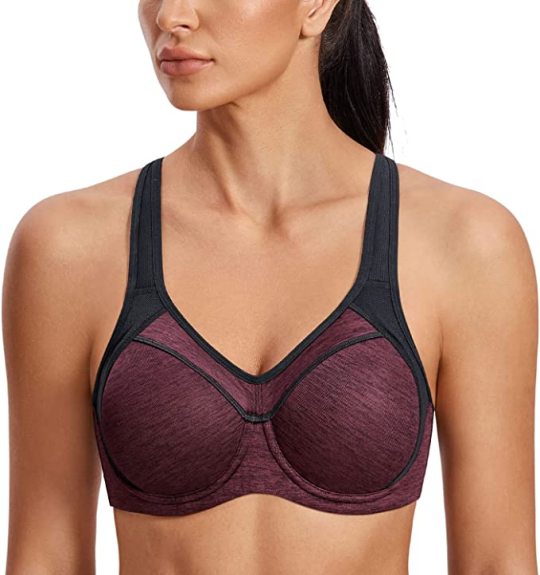
View On WordPress
#adaptability#backpacking#body changes#bra sizing#chafing prevention#hiking#hiking gear#Long-distance hiking#pacific crest trail#pct#sports bras#trail adventures#trail essentials
3 notes
·
View notes
Text
Can't wait to go camping again

2 notes
·
View notes
Text
Our Two Constants
If you have been hiking for awhile there may be one or two things that you always take with you, or something that serves as your touchstone. (See Dorothy Brown Kwaiser's story, "The Things They Carried" in Crossing Paths a Pacific Crest Trailside Reader) If you have just begun hiking you may find that your reference points are the 'Ten Essentials' or some other item or items that a mentor has conveyed to you as a must have. Rees and I have been hiking for quite a while. We have noticed how what we started hiking with; packs, clothing, etc. has morphed over the years.
Someone we know recently asked us "What is the one thing that you started with that you still carry today?" Before I answer that, let me give you a little context. Rees and I along with our longtime hiking partner and dear friend Jim started hiking the PCT in 1981. I know this makes us sound ancient but really we aren't...or at least we don't feel that way. Nevertheless this question got us to thinking and examining what we carried then compared to what we carry now. This was a very interesting exercise on many levels. It taxed our memories, brought some smiles, and helped us realize just how far we have come since then.
To begin with, we still carry something to carry water in, we still use a tent, sleeping bag, and other basics. However even those items have morphed over time. Some have gotten lighter, some more adaptable, and some have been retired altogether. In the picture below notice my rag wool sweater, cotton army surplus dungarees, and my external frame pack. Rees was ahead of his time with an internal frame pack and had the sense to bring army surplus trousers (at least they were wool!). What you can't see are our heavy weight leather hiking boots.
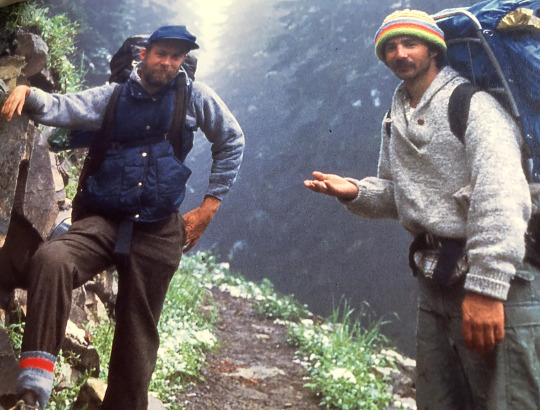
Rees and I in 1981 experiencing another sunny warm day along the Washington PCT. Is that snow along the trail or hail?
This past fall Backpacker magazine published a fiftieth anniversary edition. In it they feature items that have stood and stumbled over the test of time. There is the familiar Nalgene bottle, vintage 1972 and the Petzel headlamp, vintage 1981 among other items that mostly came later. We didn't have headlamps on our trip in 1981. We were much too poor to afford such things and much to close to our youthful Boy Scout experiences to not just bring flashlights. I don't think we had Nalgene bottles until much later. Despite the fact Therm-a-Rest sleeping pads were available economics kept them out of our reach. We were on a budget, our sleeping pads were of the blue closed foam variety..
As we tried to answer the question and recalled the things on our packing list then and now, two items appear to have stood the test of time. I am not counting the Gore-Tex anorak I brought along as I have not brought Gore-Tex every time we have gotten on the trail, somewhat regrettably . The two things that have been with us from the very beginning have been journals/writing implements and (drum roll please!) ... a pocket knife.
Today our gear is lighter and more functional. Technology has caught up and we wear more garments that are less natural and more synthetic. Our food is similar but we have added some freeze dried meals. We all have headlamps and inflatable style sleeping pads. The trusty old pocket knife and journals remain in our possession to this day. While others are electronically journaling, our habit is kind of 'old school'. A pocket knife is also old school. We have added some things too but that is a topic for another post.
What do you carry today that you carried when you first began your hiking life? Please share those with us and we will happily post your items and your experiences here. Have things changed for you as they have for us?
#Ten Essentials#Crossing Paths a Pacific Crest Trailside Reader#hiking gear#journaling#Dorothy Brown-Kwaiser#Pocketknife
2 notes
·
View notes
Text

@sindreaalberg
See more like this.
#winter#snow#snowing#snowy#wintercore#winterscape#hike#hiking#wanderlust#travel#explore#norway#europe#backpack#blonde#long hair#hiking gear#trees#landscape#li_destinations
5 notes
·
View notes
Text
Big name in hiking gear crossword: Why Your Equipment Matters

People who love to hike, backpack, and camp will posit that the equipment needed for these Big name in hiking gear crossword activities is worth the investment. Some of the most essential pieces of gear are a pack, boots, rain gear (depending on where you’re hiking), headlamp or flashlight (depending on what time of year it is), sleeping bag/pad/tent, first-aid kit, map and compass (again depending on your destination), provisions for a backpacking menu which includes items like food and water filters. Hikers should also research their destination before setting off so they know what to expect regarding terrain, weather conditions, and timing.
The following are ten things a hiker should invest in for their trip.
First-aid kit:

A first-aid kit gives you something to do while waiting for help. It can also be used if you must come back quickly or get hurt. Having it on your person provides peace of mind and can save you from calling 911 even though the situation may not be life-threatening. Respiratory and cold/flu medications help alleviate some symptoms associated with hypothermia, sunburn, insect bites, and various cuts and scrapes from hiking through wilderness areas. Also, a first-aid kit can be used to help others in an emergency situation if you’re a community caretaker.
If you find yourself hiking through a wilderness area, make sure to hike with one and learn how it works so it won’t get lost or misplaced.
Spare batteries are also essential to include in your kit as they are necessary for any small electronic device such as watches, flashlights, and radios. Spare batteries can even help if you locate your items after hours of hiking. Having extra ones on hand will ensure you don’t have to wait for someone else to fix the problem.
Water bottle.
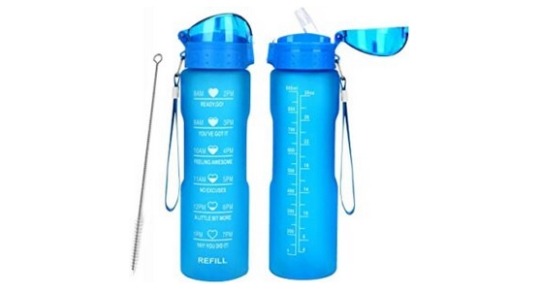
Not only does a hiking water bottle provide you with water on the trail, but if you start a fire and are suddenly stranded in the wilderness, having a water bottle to keep your drinks cool makes it easier to stay hydrated. As stated earlier, extra batteries are also essential to have on hand, and many items in your pack can burn out if they aren’t used.
Duct tape is also necessary because it can be used as makeshift bandages when minor cuts or scrapes occur. It can also be used for various other applications, such as securing items in your bag or fixing broken items on your backpack.
Sleeping bag/pad/tent combo.

A pad is used in warmer weather and works exceptionally well if the weather turns cold for whatever reason during your trip. There are various pads for backpackers, including ones made of synthetic materials or pads designed with waterproof coating, which helps keep moisture from leaking from within your sleeping area and keeps mildew from spreading inside your equipment. Check this Single Gear Reviews.
This can be a sleeping bag or a pad to keep you warm. Both are lightweight and easy to pack, which makes hiking more enjoyable. A sleeping bag is good in cooler weather as it can be wrapped around you to keep you warm, and sometimes a blanket is even used instead of the sleeping bag.
Water filter

A water filter can be used in place of purchasing and carrying bottled water. These are lightweight and compact, so they don’t add too much to your pack or weigh you down while hiking. And when you’re done with your water, it also helps to save the environment since you no longer have to carry all those plastic bottles that can end up in the ocean or landfill sites. Check this Single Gear Reviews.
Map and compass (depending on your destination).

Maps can be valuable for hikers looking for new trails or remote areas to explore. When hiking in a wilderness area, knowing the map can ensure that you won’t get lost by not knowing how to navigate from one side of a ridge to another using landmarks and compass directions. It can also help if you plan to camp in an area you have never been to. Check this Single Gear Reviews.
A compass is a way to measure the direction of gravity and the north pole. Knowing how to use your compass will help you make your way back if you are lost while hiking, hunting, or camping in the wilderness. It can also lead you back to a trail if you get turned around, which is essential since GPS devices often don’t work in certain places. With a map and measuring tools, it can be easy to find your way out of any situation should something happen during your hike, such as losing a piece of gear, getting injured or sick, or experiencing adverse weather.
Hiking boots (depending on your destination).
Footwear.
Footwear is essential to bring when planning a hike. It reduces the risk of blisters and helps avoid injury by keeping you comfortable while hiking. Different types of boots depending on your activity, such as hiking, backpacking, or camping in a tent. Low-cut or high-cut boots can keep your feet dry, but if you don’t mind getting your feet wet, waterproof raingear can also be used in place of boots.
Rain gear can also be used if it rains during your trip, and it protects against wetness by keeping you warm and dry.

If hiking new terrain or a trail hasn’t been explored, hiking boots can be a must. Hiking boots are essential for traveling in rocky areas and trekking through rugged ground because they have a large amount of traction necessary to travel over rocks, small branches, and uneven terrain. The elevation gain and loss of hikers’ weight are not evenly distributed throughout the feet; therefore, having good traction will ensure that your feet don’t get sore from walking across various surfaces. Hiking boots can also be used on the trail if you plan to hunt in the wilderness area. Check this Single Gear Reviews.
Final words:
When it comes to selecting the right hiking gear, trust your judgment. However, if you’re looking for a bit of guidance, consult a reputable source like topgearlab.com, which offers comprehensive crosswords of hiking and camping gear. With so much information at your fingertips, making the perfect purchase is easier than ever!
2 notes
·
View notes
Text
Camping In A Brand-New Place Is Always An Experience. And, If You Are Camping In Snow, Winter Season Camping Will Be A Whole Various Level Of Challenge
Camping is associated with household experience. Going on a camping trip far from the pressure of life and into uncharted area can be incredibly exciting, fulfilling and memorable.
Camping is a popular family activity due to the fact that it supplies a minute of escape and discovery. Camping deals an opportunity to unplug from electronic devices, unwind, leave the routines of life, get some fresh air and explore brand-new surroundings. It has such power to connect people as well as households in both significant and spirited ways - a place together where everybody is free to be themselves and experience something brand-new together.
Camping in a brand-new location is always an experience. And, if you are camping in snow, winter camping will be a whole different level of obstacle.
Experience informs us that the type of devices that you have with you will have a huge influence on the quality of your time outdoors.
Starting off with a fresh new year is a fantastic time to set some brand-new outdoor obstacles and make your experiences more interesting.
Winter season camping, while not as popular in North America as in Europe, is an exceptional possibility to explore nature and accept the cold without compromising on convenience.
Camping during winter season can feel like even more of an adventure than camping during the summer. Hot Tent Camping In Snow On Mount Hood of bugs and heat will make it much easier to delight in nature with all 5 senses. You will have the ability to hear the sweet sound of snow crunching under your boots, feel the bite of cold wind against your cheeks, see the incredible contrast in between patches of pristine white snow and dark green pine trees and smell a fire that crackles next to you.

If you're feeling a bit tired with your normal summer camping, you can try winter season camping - with best gear and understanding. Prepare yourself well and with someone experienced.
2 notes
·
View notes
Text
Hiking Gear & the 10 Essentials
So, I'm prepping to go on my first solo winter hike tomorrow, and in making sure I'm geared up, I'm going through my pack and making sure I have 'The Ten Essentials'
What are the Ten Essentials? The general consensus and list from REI says:
Navigation
Illumination
Sun protection
First aid
Knife + a gear repair kit
Fire
Shelter
Extra food
Extra water
Extra clothes
So, here's my pack:
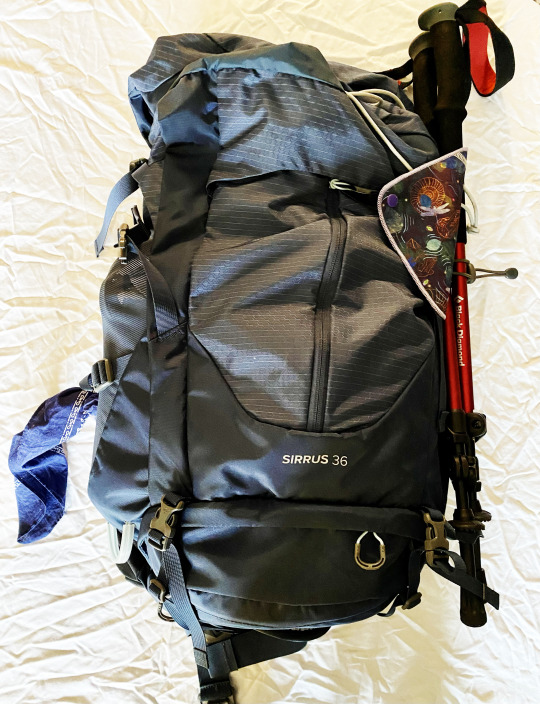
It's a 36 liter pack, has an adjustable waist and chest strap, and it's very comfortable and great for making sure I can carry what I need. Here's what's inside...

Navigation
I have a set of maps of the mountains in the various subranges of the range I enjoy hiking in, and have a small compass that attaches to my pack's shoulder strap. I can bring whichever map is relevant to the hike I'm doing that day and slide it into its plastic pouch to keep it dry!
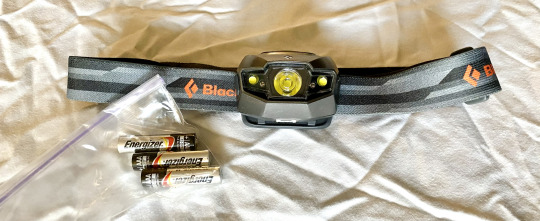
2. Illumination
This means headlamp! If you get caught out after dark, having a headlamp is pretty essential so that you can see the trail markers and get back down without getting lost or badly injured. I keep the batteries in a separate baggy to prolong battery life, and test them before hiking to make sure they work.

3. Sun Protection
In the summer, I will bring a tube of sunscreen with me and reapply during my hike; in winter I sweat a lot less and am more covered up, so I admit, I just apply some in the parking lot, especially when most of the hikes I do are in the shade. But I always bring sunglasses with me! It can get pretty bright up on the summit.

4. First Aid
Okay, I go a little overboard here, but having been seriously injured on the trail, I err on the side of being prepared. I have a comprehensive first aid kit for longer outings, glacier gel for blisters, afterbite for insect strings and bites, a lightweight foam splint for broken bones, medical tape, and an ace bandage. There's also a little pouch with an antiseptic wipe, a few bandaids, and some advil and tylenol that I keep in an easy-to-reach pocket -- on very short outings, I sometimes just take this. If I'm hiking with someone else and they have a first aid kit, I may leave some of this behind since there's not that much need for redundancy. But if I'm solo or the most prepared in a group, I make sure I'm stocked up.

5. Knife + Gear Repair
I call this my MacGyver kit. If something tears, breaks, or is otherwise borked, I can probably rig up a temporary fix with this. I have, left to right, some duct tape, a swiss army knife, zip ties, safety pins, and a spare bootlace. Great for reattaching broken straps, fixing a broken boot, assembling shelter, etc.
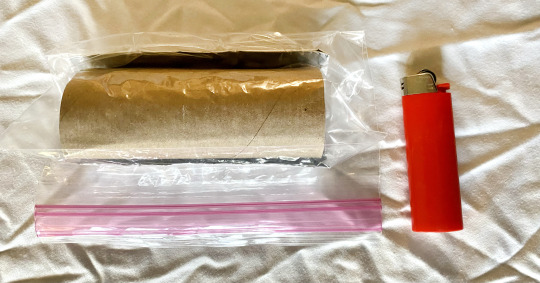
6. Fire
I deeply hope I'm never in a situation where I am so fucked I need to build a fire out in the wilderness to survive the night, but if I ever am that fucked, this will help. I have a lighter, and a bit of tinder -- in this case, a toilet paper roll stuffed with dryer lint, to use as a fire starter.

7. Shelter
Again, never want to have to spend an unintentional night outdoors, but if I do... Here I have two itty bitty things that could save my life. There's an emergency bivvy -- basically a plastic sleeping bag that you can climb into that will keep out water and reflect some of your body heat back at you, weighs about 4.5 ounces -- and a space blanket. Combining these, in addition to building a fire and using my knife and other supplies to rig together a lean-to out of branches to keep myself out of the wind, I could probably make it through a cold mountain night in a worst case scenario situation.

8. Extra Food
You burn through a lot of calories on the trail, so it's always good to have snacks. I often bring a sandwich and maybe a cookie to eat on summit, but in addition I have nonperishable sugar- and protein-rich snacks, such as trail mix and granola bars. I also keep a spare baggie for my trash!
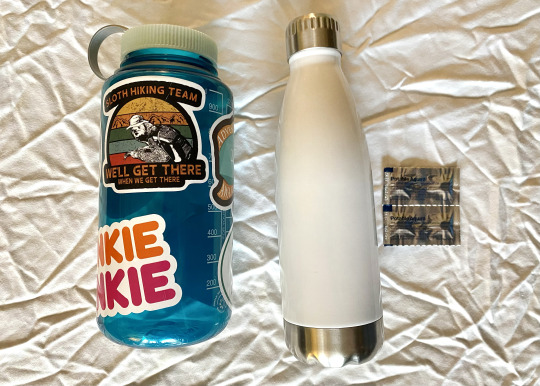
9. Extra Water
In the summer, I always bring two liter-sized water bottles with me because I drink like a fish, and dehydrating on the trail is a big problem. In the winter, where I sweat less and get less thirsty, I've been bringing a liter and a half with me and doing fine (I usually drink the liter on the hike, and polish off the rest back down in the parking lot). But I also have water-purifying tablets with me, in the event I wind up lost and in need of water -- there's a lot of natural streams and water sources near the trails around here, but there's also a lot of wildlife so some method of water purification is necessary if you're going to drink from them if you don't want to ingest some microbe that's gonna make you sick as hell.

10. Extra Clothing
I will probably be fine on this hike with a thermal shirt and a fleece jacket, but I am packing my puff jacket just in case, as well as extra gloves and extra socks, in case I slip on a water crossing and get my feet wet. My puff folds up pretty small and is very lightweight while being very insulating, so it's perfect for winter hikes. In the summer, for a low-altitude hike, I will often bring a sweater and a windbreaker. Usually when I'm hiking, I'm VERY warm, but as soon as I stop moving, be it to take a breather, to enjoy the view on summit, or if Something has Gone Wrong™, I'm going to get chilled and want those added layers.
And a few extras that aren't on the list, but which I bring with me...

BONUS: SOS
Whistle! This is a simple thing, but if I'm hurt or lost and need help, I can blow a whistle a lot louder and for a lot longer than I can yell. Three short blasts means "Hiker in distress" and the sound will carry. And unlike a cell phone, whistles don't need signal or batteries.

BONUS: Sanitation
Yeah, sometimes, you gotta pee in the woods. For that, I have my kula cloth (antimicrobial reusable self-sanitizing pee cloth that clips to the outside of my pack), a pee funnel so I can pee standing up without dropping my pants and having to awkwardly squat, and in the event I'm ever out long enough that I gotta number two, something to wipe with and a plastic bag to carry my wiping material out with so I don't leave dirty tp out in the woods.
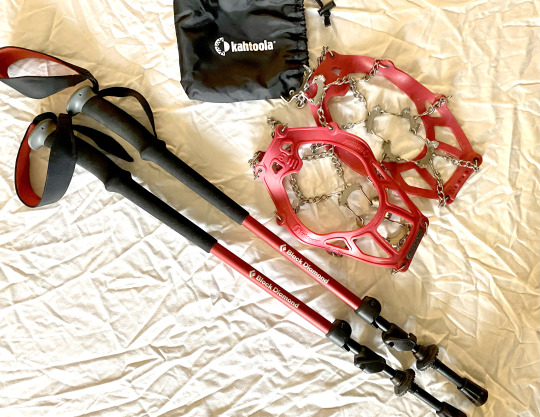
BONUS: Traction & Mobility
For winter hiking, I bring my microspikes. These are a rubbery frame that slides on over your boot with little chains with short metal spikes on the bottom, which dig into the ice you're walking on to give you traction so you don't slip.
I also love bringing my trekking poles on hikes to help with my balance, stability, and impact on my shitty knees.
So, that's my full inventory of gear! Feel free to drop any questions in my askbox.

41 notes
·
View notes
Photo

Alexander Rhind
Snow+Rock
Alexander Rhind ventured to the Brecon Beacons National Park to photograph a Spring/Summer 2022 campaign for the outdoor clothing retailer, Snow+Rock. For the shoot, Alexander and his crew hiked with the talent up Pen y Fan, the largest peak in South Wales. Alexander captured the hikers in their gear as the sun rose over the mountain. The pastel greens and blues of the early morning light complement the soft earth tones of South+Rock’s apparel.
See more from Alexander Rhind’s latest campaign for Snow+Rock on his Lifestyle and Advertising portfolios online.
#saint lucy reps#saint lucy represents#alexander rhind#snow + rock#pen y fan#south wales#outdoor photography#hiking photography#commercial photography#landscape photography#outdoor lifestyle#outdoor apparel#hiking gear
2 notes
·
View notes
Text
India, renowned for its diverse landscapes and breathtaking natural beauty, offers an abundance of hiking trails that cater to both seasoned adventurers and casual nature enthusiasts. From snow-capped mountains to lush forests, here are the top five hiking destinations in India that promise unforgettable experiences amidst stunning scenery:
1.Roopkund Trek, Uttarakhand:
Nestled in the Garhwal Himalayas, the Roopkund Trek is a challenging yet rewarding expedition. The highlight of this trek is the mysterious Roopkund Lake, also known as Skeleton Lake, which is surrounded by snow-clad peaks and offers mesmerizing views. The trail winds through dense forests, alpine meadows, and rugged terrain, providing adventurers with an immersive experience in the lap of the Himalayas.
2.Valley of Flowers, Uttarakhand:
Declared a UNESCO World Heritage Site, the Valley of Flowers is a paradise for nature lovers and hikers alike. Located in the Chamoli district of Uttarakhand, this enchanting valley blooms with a vibrant carpet of alpine flowers during the monsoon season. The trek to the Valley of Flowers offers breathtaking vistas of snow-capped peaks, cascading waterfalls, and meandering streams, making it a haven for photographers and outdoor enthusiasts.
3.Hampta Pass Trek, Himachal Pradesh:
Situated in the Pir Panjal range of the Himalayas, the Hampta Pass Trek is renowned for its dramatic landscapes and diverse terrain. This moderate-level trek takes hikers through lush green valleys, remote villages, and high altitude passes, offering panoramic views of towering mountains and glacier-fed rivers. The highlight of the trek is crossing the Hampta Pass, which provides a thrilling sense of achievement and awe-inspiring vistas of the surrounding peaks.
4.Kangchenjunga Base Camp Trek, Sikkim:
For those seeking a truly remote and off-the-beaten-path adventure, the Kangchenjunga Base Camp Trek in Sikkim is an ideal choice. Named after the third highest peak in the world, this trek offers unparalleled views of Kangchenjunga and its neighboring peaks. The trail winds through pristine forests, alpine meadows, and picturesque villages, allowing hikers to immerse themselves in the rich culture and biodiversity of the region.
5.Sandakphu Trek, West Bengal:
Located in the Singalila National Park, the Sandakphu Trek is renowned for offering panoramic views of the world's highest peaks, including Mount Everest, Makalu, Lhotse, and Kanchenjunga. This moderate-level trek takes hikers through dense rhododendron forests, picturesque villages, and high altitude landscapes, culminating in the summit of Sandakphu, which is the highest point in West Bengal. The breathtaking vistas of the Himalayan range from Sandakphu make it a must-visit destination for avid hikers and nature enthusiasts.
In conclusion, India's diverse terrain and rich biodiversity offer a plethora of hiking opportunities for adventurers seeking to connect with nature and explore the beauty of the Himalayas. Whether you're an experienced trekker or a novice hiker, these top five hiking destinations in India promise unforgettable experiences amidst some of the most spectacular landscapes on Earth.
0 notes
Text
The Ultimate Day Hiking Checklist
Learn what to carry to maximize enjoyment and safety on your day hikes.
Embarking on a day hike can be a marvelous adventure, and preparing adequately ensures a memorable and safe experience. This day hiking checklist is tailored to equip you with everything you need, from essential clothing to hydration and nutrition. Let's dive into the essentials for your next day hike.

Essential Clothing and Footwear
For a comfortable hike, it's crucial to wear appropriate clothing and footwear. Start with a durable pair of hiking boots that offer good ankle support. Pair these with moisture-wicking socks to keep your feet dry. Depending on the weather, layer up with breathable fabrics, and don’t forget a hat and sunglasses to protect against the sun.
Backpack and Gear Checklist
A sturdy backpack is indispensable for carrying your gear. Make sure it has enough compartments for easy organization but is lightweight enough to carry comfortably over long distances. Essential gear includes trekking poles for stability, a camera or binoculars for capturing the beauty of nature, and a rain jacket for sudden downpours.
Navigation Tools
Never underestimate the importance of navigation tools on your hike. Always carry a map and compass, and consider a GPS device for extra security. A cell phone with GPS capabilities and downloaded trail maps can also serve as a backup navigation aid.
Emergency Supplies
For unforeseen circumstances, pack emergency supplies such as an emergency shelter, a whistle for signaling, and a flashlight or headlamp with extra batteries. These items can be lifesavers in critical situations.
Hydration and Nutrition
Staying hydrated is vital, so carry sufficient water and consider a lightweight water filter for longer trails. For nutrition, pack high-energy snacks like trail mix and energy bars to keep your energy levels up throughout the hike.
First Aid Kit
A well-stocked first aid kit is a must-have on any hiking checklist. Include items for treating minor injuries and any personal medications. Make sure you know how to use each item in your kit.
Sun Protection
Protect yourself from the sun's harsh rays by applying sunscreen regularly, wearing a hat, and using sunglasses. Sun protection is not just for comfort but also for preventing sunburn and heatstroke.
Insect Protection
Insect bites can be not only irritating but also dangerous. Carry insect repellent and consider wearing long sleeves and pants to protect against ticks and mosquitoes.
Trail Snacks and Meals
For longer day hikes, bring more substantial meals along with your snacks. Pack items that don’t require refrigeration and are easy to eat on the trail, such as sandwiches or wraps.
Leave No Trace Principles
Adhere to the Leave No Trace principles by keeping the trails clean and undisturbed. Pack all your garbage, including organic waste, and be considerate of wildlife and other hikers.
By following this detailed day hiking checklist, you’ll be well-prepared for your outdoor adventure. Whether you're a seasoned hiker or a newcomer to the trails, having the right gear and being prepared for various conditions can make your day hike a delightful experience. Remember, every item on your checklist plays a role in ensuring your hike is enjoyable, comfortable, and safe.
FAQ
What are the most important items to bring on a day hike?
The essentials for a day hike include a backpack, water, snacks, appropriate clothing for the weather (layering is key), sturdy footwear, a map and compass or GPS, a first aid kit, and sun protection. Additional useful items might include a knife or multi-tool, a headlamp or flashlight, and an emergency shelter or space blanket.
How much water should I carry on a day hike?
The amount of water to carry depends on various factors including the length of the hike, the weather, and your personal hydration needs. A general rule of thumb is to carry about half a liter of water per hour of moderate activity in moderate temperatures. It’s always a good idea to carry a bit more than you think you'll need, or have a way to purify water from natural sources if available on your route.
Is it necessary to carry a physical map and compass if I have a GPS device?
Yes, it is advisable to carry a physical map and compass as a backup. Technology can fail, batteries can drain, and GPS signals can be unreliable or inaccurate, especially in remote areas or under dense canopy. A physical map and compass are reliable, lightweight backups that can be crucial in an emergency.
Hiking Pants
Hiking Shorts
Waterproof Hiking Boots
Hiking Boots for Women
Hiking Boots for Men
Hiking Sandals
Hiking Sandals for Women
Hiking Poles
0 notes
Text
Camplify’s must-have tips for embracing the journey of solo travel
To help you navigate solo travel, Camplify presents an in-depth exploration of essential tips to ensure an unforgettable trip.
Embarking on a Solo Travel Expedition
Embarking on a solo travel expedition is akin to stepping into a realm of boundless possibilities, where each encounter and experience shapes your journey in unique ways. To help you navigate the exhilarating world of solo travel with confidence and ease, Camplify presents an in-depth exploration of essential tips to ensure an unforgettable trip.
Prioritise…

View On WordPress
#adventure preparedness#adventure travel#adventurous solo travel#audiobooks for travel#Camplify#connecting with nature#driving limits#embracing solitude#emergency kit#emergency preparedness#exploring nature#exploring solo#exploring the unknown#fatigue management#first aid essentials#hiking essentials#hiking gear#hobby travel#journaling#journey preparation#keeping in touch#making friends while traveling#meet new people#nature escapades#navigation apps#open-minded travel#outdoor adventures#personal safety#photography#quality travel gear
0 notes
